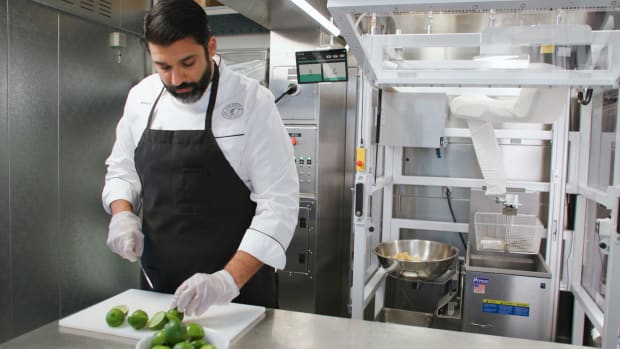With so many workers pulling away from their retail jobs during the Great Resignation, businesses have had to either shut their doors or improvise.
Many companies are raising their hourly pay and boosting their benefits as a way to draw in a new workforce (or perhaps lure back some of the people they lost last year). And while this might be a success for companies like Target (TGT), which can afford to pay its people $24 an hour, not all are able -- or willing -- to go to such lengths.
The Newport Beach, Calif., burrito giant (CMG) has a completely different idea how to manage the staffing problem and keep its business flowing smoothly at the same time. It's a fascinating concept, and one that we'll surely see more of as technology continues to evolve.
But while the method means we may get our food much faster, it also poses new questions about the direction of restaurants. And it could lead to a future in which hourly workers are no longer needed at all.

Chipotle
Which New Tech Is Chipotle Introducing?
Chipotle said it was testing out a new robot in its Chipotle Cultivate Center, the fast-casual chain's innovation hub in Irvine, Calif., for implementation in its restaurants in the near future.
Chippy, as Chipotle calls the autonomous kitchen assistant, is programmed to replicate the company's exact recipe to create its tortilla chips, even going as far as to ensure the robot can imitate even the variations of a previously handmade product.
Chippy was created by Miso Robotics, the Pasadena, Calif., specialist in automated solutions for restaurants.
Chippy isn't Miso's first robot. It also produces Flippy 2, a high-volume fryer that utilizes a robotic arm to remove food when it's at the perfect level of golden brown. White Castle. the closely held Columbus, Ohio. burger chain, just greenlit 100 of them to be added to more of its locations after a successful pilot program in the Chicago area.
"By taking over the work of an entire fry station, Flippy 2 alleviates the pain points that come with back-of-house roles at quick-service restaurants to create a working environment for its human coworkers that maximizes the efficiency of the kitchen," Miso's website says.
Chipotle later this year plans to test Chippy in a Southern California location so it can gather feedback from both its crew and customers before it decides whether to move forward with installing the robot in more locations.
Do Robot Innovations Mean Fewer Jobs for Humans?
Naturally, robotic assistance in a fast-food setting has many advantages, such as being able to tirelessly churn out chips for 16 hours straight without lunch or bathroom breaks.
But for some, automating jobs that hourly workers once held means fewer jobs, and that is a frightening prospect to those who make a living in those roles. And while that's certainly not impossible, it's a fairly black-and-white way to imagine what a future of coexisting with robots could be like.
Asian countries are far ahead of America in this process, having used robotics in a wide variety of applications for many years. While many act as servers, some also aid the disabled by allowing them to still work and communicate, as shown at Dawn Cafe in Tokyo below. Here, real people control the robots remotely, which allows them to still work a job and earn a salary despite their disabilities.
In other settings, the robots work in tandem with human employees to eliminate small, repetitive tasks such as serving drinks and taking orders, allowing humans more time to do their jobs better.
While some worry that robots will eventually eliminate their jobs, the reality is that the cost would be enormous to execute. We're more likely to continue to see them assist humans and help pare down the elements of a job that exhaust workers. That will leave people more energy to provide a crucial part of service that robots have yet to master: human-to-human connection.







